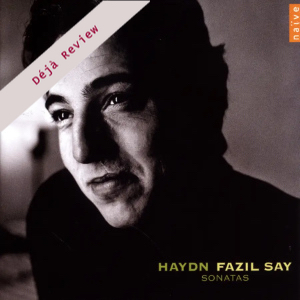
Déjà Review: this review was first published in July 2007 and the recording is still available.
Joseph Haydn (1732–1809)
Piano Sonata No 37 in D
Piano Sonata No 43 in A-flat major
Piano Sonata No 35 in C
Piano Sonata No 31 in E
Piano Sonata No 10 in C
Fazil Say (piano)
rec. 2006, Théâtre des Quatre Saisons, Gradignan, France
Naïve V5070 [59]
Fazil Say’s middle name must be “controversial”.
His Beethoven sonatas disc for Naïve divided critical opinion upon release. Some – including me – valued it for giving voice to the angst and tumult inside much of the composer’s writing. Others found the emotions evident in the playing to be too strong and misplaced: “A wild young man of the keyboard with really very little to say,” one eminent critic wrote. My colleague Kevin Sutton found Say’s “moaning and groaning” at the keyboard a distraction from the playing also.
The composer might have changed with this new recording, but the results make one sit up and take notice for better or worse from the very first notes of the D major sonata. Clearly Fazil Say has not lost any ability to shock with his playing, for this is no run-of-the-mill Haydn sonatas disc. The outer movements of his selected sonatas are wont to trip along sprightly enough, but it is the details of accents and chordal sonorities that after a short while begin to keep ones eyebrows firmly raised at what is going on.
The Rondo-Presto which closes sonata no. 43 is the most extreme example of impulsive contrast to be heard on this recording. For the most part it is phrased with some care, but at times the ends of phrases are reduced to humourless, disjointed single notes. Was this really what Haydn had in mind? Say, a composer himself, would like us to think so, but I am not wholly convinced. It seems to run so counter to the spirit of the movement thus far.
The feeling that wit has been sidelined in favour of pianistic effect seems almost inescapable in the sonatas that follow and on subsequent auditions of the disc as a whole. More is the pity, as Haydn’s sonatas are fine things and can always do with sterling advocacy. Whilst there is no doubting Say’s technical abilities, it’s a shame that he seems so reticent to let the music have its natural shape and voice. That said, when heard in careful isolation there are observations in individual movements that can delight, which a pianist of lesser facility might fail to bring out: the menuet of the sonata no. 10 carries cleanliness of articulation and definition of body as integral to the whole, for example. Here though, as so often throughout the recording, the result is tempered by Say’s obvious vocalisation. Putting up with such things in the concert hall is bad enough, but some self control in the recording studio might have been exercised.
Some mercifully brief thoughts from Fazil Say and more extensive notes on Haydn’s sonatas by Andreas Friesenhagen adequately set the scene in the booklet.
For all its points of contention this recording is hard to ignore and is certainly a Haydn recital like you’ve never heard before.
Evan Dickerson
If you purchase this recording using a link below, it generates revenue for MWI and helps us maintain free access to the site



















